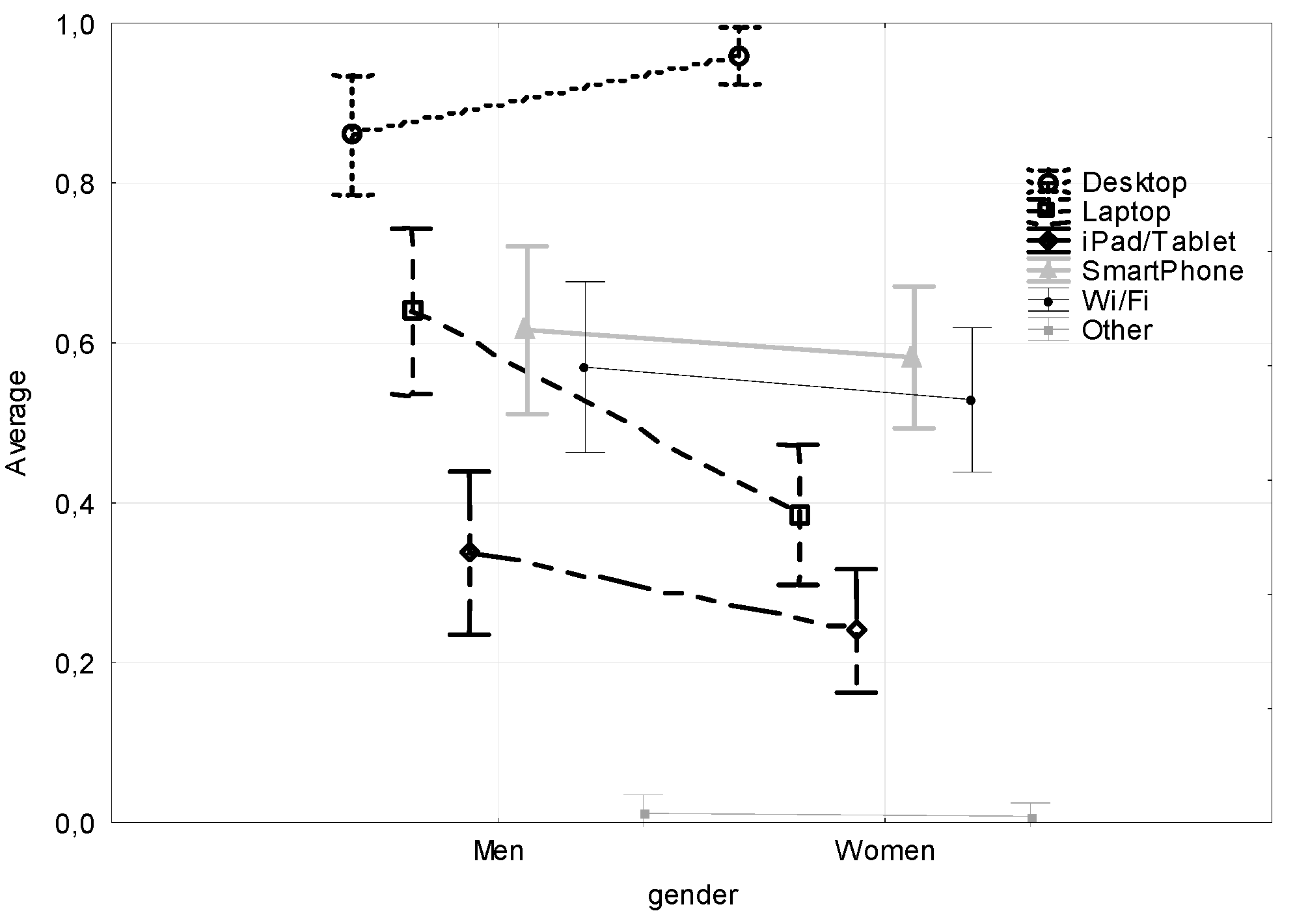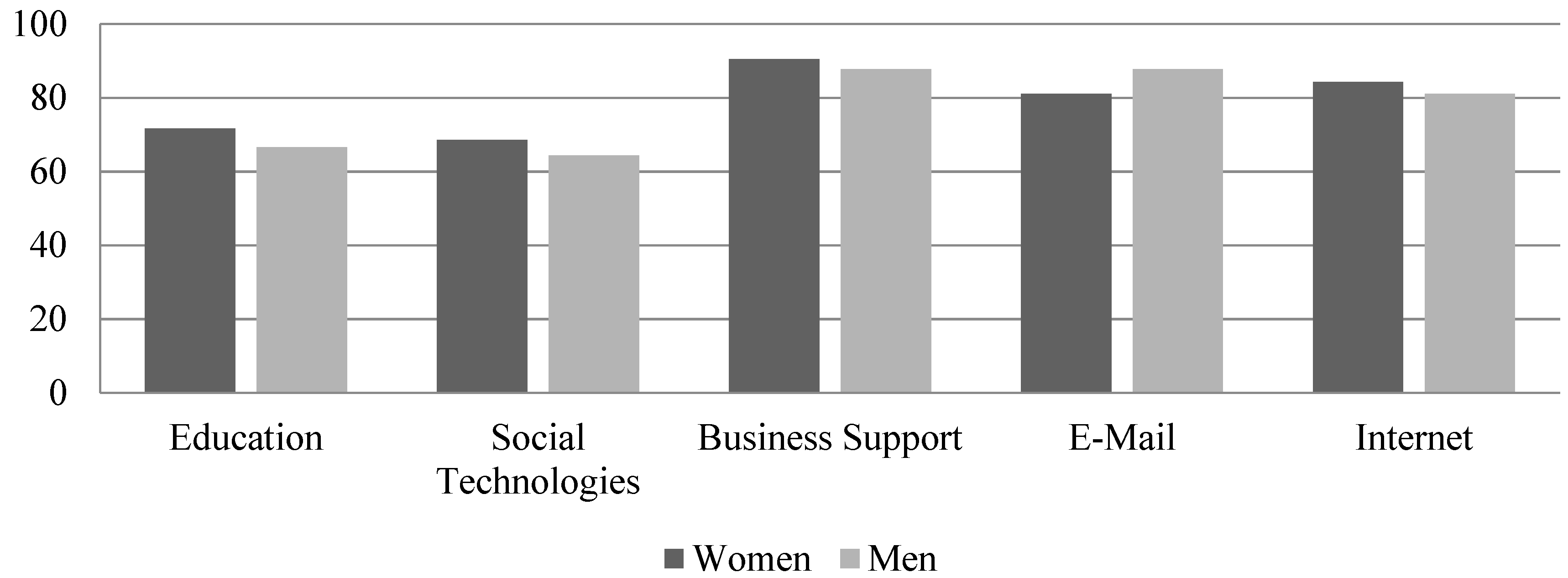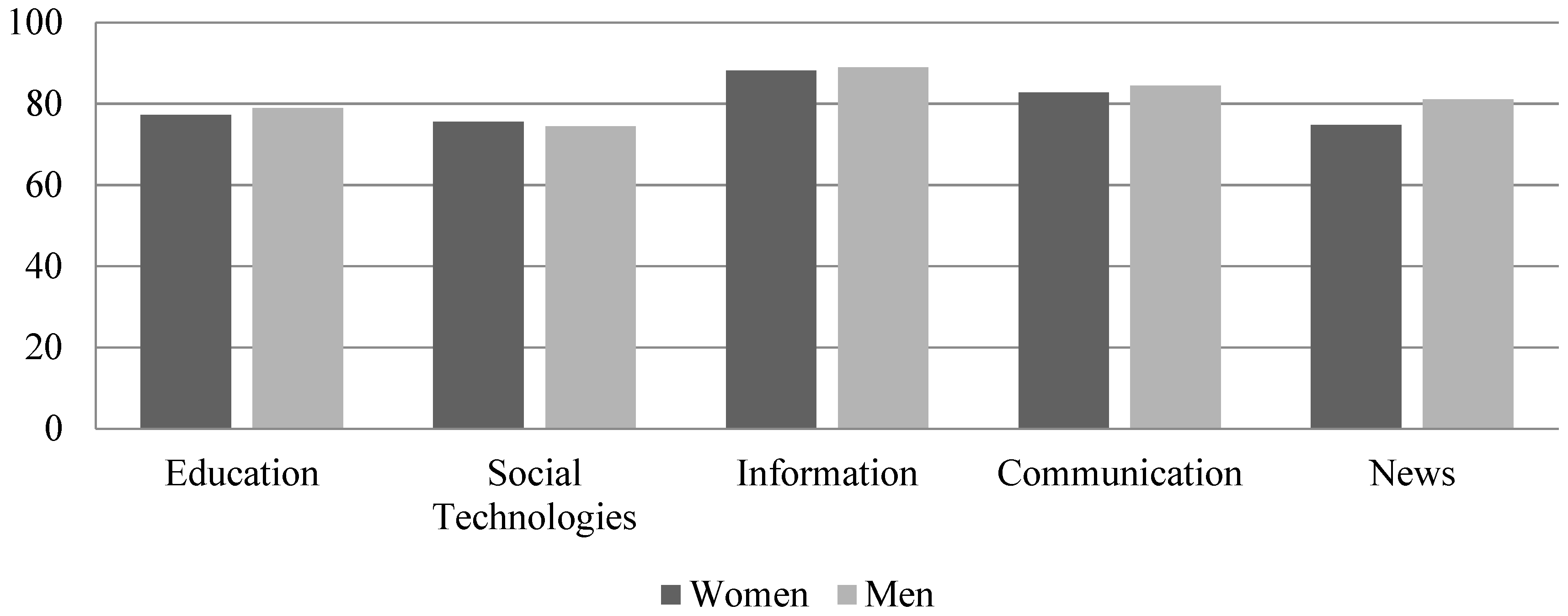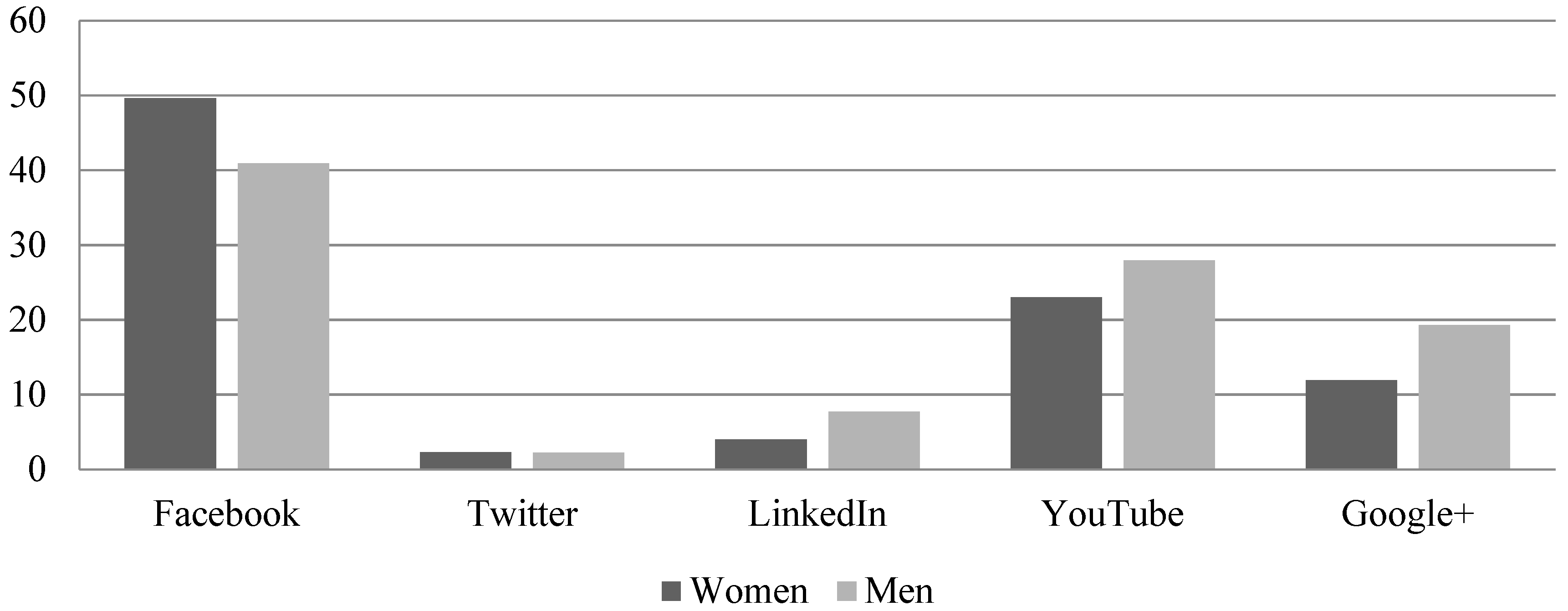Digital Media: Empowerment and Equality
Abstract
1. Introduction
- (1)
- Is there a difference in the results for women versus men?
- (2)
- Can social technology platforms provide tools for empowerment?
2. Literature Review
2.1. The Gender Gap
2.2. Empowerment
2.3. Digital Media
3. Materials and Methods
3.1. Instrument and Materials
3.2. Methods
4. Sample
5. Results
5.1. Technology
5.2. Social Technologies
5.2.1. Facebook
5.2.2. YouTube
5.2.3. Google+
5.3. Empowerment
6. Discussion
7. Conclusions
Author Contributions
Funding
Acknowledgments
Conflicts of Interest
References
- Cascio, W.F.; Montealegre, R. How Technology Is Changing Work and Organizations. Annu. Rev. Organ. Psychol. Organ. Behav. 2016, 3, 349–375. [Google Scholar] [CrossRef]
- Haddud, A.; Dugger, J.C.; Gill, P. Social Media for Organizations Exploring the Impact of Internal Social Media Usage on Employee Engagement Journal of Social Media for Organizations Exploring the Impact of Internal Social Media Usage on Employee Engagement. J. Soc. Media Organ. 2016, 3, 1. [Google Scholar]
- Subramanian, K.R. Technology and Transformation in Communication. J. Adv. Res. Electr. Electron. Eng. 2018, 5, 1–13. [Google Scholar]
- Cairo, A. Managing employees in a social media technology workplace. N. Z. Manag. 2014, 61, 21. [Google Scholar]
- Paliszkiewicz, J.; Koohang, A. Social Media and Trust: A Multinational Study of University Students; Informing Science Press: Santa Rosa, CA, USA, 2016. [Google Scholar]
- Logan, R.K. Understanding humans: The extensions of digital media. Information 2019, 10, 304. [Google Scholar] [CrossRef]
- Nicholas, D.; Rowlands, I. Social media use in the research workflow. Inf. Serv. Use 2011, 31, 61–83. [Google Scholar] [CrossRef]
- Mital, M.; Sarkar, S. Multihoming behavior of users in social networking web sites: A theoretical model. Inf. Technol. People 2011, 24, 378–392. [Google Scholar] [CrossRef]
- Merchant, G. Unravelling the social network: Theory and research. Learn. Media Technol. 2012, 37, 4–19. [Google Scholar] [CrossRef]
- Chou, C.M. Social media characteristics, customer relationship and brand equity. Am. J. Bus. 2019, 10, 128–139. [Google Scholar]
- Ngai, E.W.T.; Moon, K.K.; Lam, S.S.; Chin, E.S.; Tao, S.S. Social media models, technologies, and applications: An academic review and case study. Ind. Manag. Data Syst. 2015, 115, 769–802. [Google Scholar] [CrossRef]
- Lin, S.F.; Lin, C.L.; Lee, D.C. The relationship between elementary school teachers’ technology readiness and intention to use social media platforms for classroom management. Int. J. Organ. Innov. 2015, 8, 48–63. [Google Scholar]
- Selwyn, N.; Stirling, E. Social media and education … now the dust has settled. Learn. Media Technol. 2016, 41, 1–5. [Google Scholar] [CrossRef]
- Greenwood, D. Local Indicators of Quality of Life: A Preliminary Look at the Pikes Peak Region; University of Colorado at Colorado Springs, Center for Colorado Policy Studies: Denver, CO, USA, 2001; pp. 1–29. [Google Scholar]
- Hjorth, L.; Hinton, S. Understanding Social Media; SAGE: London, UK, 2019. [Google Scholar]
- Nord, J.H.; Paliszkiewicz, J.; Koohang, A. Using social technologies for competitive advantage: Impact on organizations and higher education. J. Comput. Inf. Syst. 2014, 55, 92–104. [Google Scholar] [CrossRef]
- Gholipour, A.; Rahimian, A.; Mirzamani, A.; Zehtabi, M. IMPACT Model of Women’s Empowerment. Int. Bus. Res. 2010, 3, 57–65. [Google Scholar] [CrossRef][Green Version]
- Cornwall, A.; Anyidoho, N.A. Introduction: Women’s empowerment: Contentions and contestations. Development 2010, 53, 144–149. [Google Scholar] [CrossRef]
- Lin, J.; Nord, J.H.; Paliszkiewicz, J.; Mądra-Sawicka, M. China’ s social networks: Culture, business, and the gender gap. J. Asia Entrep. Sustain. 2017, 13, 132–175. [Google Scholar]
- Nord, J.H.; Achituv, D.B.; Paliszkiewicz, J. Communication through Social Technologies: A Study of Israeli Women. J. Int. Technol. Inf. Manag. 2017, 26, 45–80. [Google Scholar]
- Amichai-Hamburger, Y.; Vinitzky, G. Social network use and personality. Comput. Hum. Behav. 2010, 26, 1289–1295. [Google Scholar] [CrossRef]
- Muscanell, N.L.; Guadagno, R.E. Make new friends or keep the old: Gender and personality differences in social networking use. Comput. Hum. Behav. 2012, 28, 107–112. [Google Scholar] [CrossRef]
- Pagani, M.; Hofacker, C.F.; Goldsmith, R.E. The Influence of Personality on Active and Passive Use of Social Networking Sites. Psychol. Mark. 2011, 28, 441–456. [Google Scholar] [CrossRef]
- Caison, A.; Bulman, D.; Pai, S.; Neville, D. Exploring the technology readiness of nursing and medical students at a Canadian University. J. Interprof. Care 2008, 22, 283–294. [Google Scholar] [CrossRef] [PubMed]
- Moghaddam, G.G. Information technology and gender gap: Toward a global view. Electron. Libr. 2010, 28, 722–733. [Google Scholar] [CrossRef]
- Lin, C.H.; Yu, S.F. Adolescent internet usage in Taiwan: Exploring gender differences. Adolescence 2008, 43, 317–331. [Google Scholar] [PubMed]
- Raffaelli, M.; Ontai, L.L. Gender socialization in latino/a families: Results from two retrospective studies. Sex Roles 2004, 50, 287–299. [Google Scholar] [CrossRef]
- Hong, Z.R.; Veach, P.M.C.; Lawrenz, F. An investigation of the gender stereotyped thinking of Taiwanese Secondary School boys and girls. Sex Roles 2003, 48, 495–504. [Google Scholar] [CrossRef]
- Hong, Z.R. An investigation of Taiwanese female college students’ sexist attitudes. Sex Roles 2004, 51, 455–467. [Google Scholar] [CrossRef]
- Aslanbeigui, N.; Pressman, S.; Summerfield, G. Toward gender equity: Policies and strategies. Int. J. Polit. Cult. Soc. 2003, 16, 327–330. [Google Scholar] [CrossRef]
- Geo-JaJa, M.A.; Paynem, S.J.; Hallam, P.R.; Baum, D.R. Gender equity and women empowerment in Africa: The education and economic globalization nexus. In Race, Ethnicity and Gender in Education; Springer: Dordrecht, The Netherlands, 2009; Volume 6, pp. 97–121. [Google Scholar]
- Marzano, G.; Lubkina, V. The Digital Gender Divide: An Overview. In Proceedings of the 2019 International Scientific Conference Society, Integration, Education, Rezekne, Latvia, 24–25 May 2019; Volume 5, pp. 413–421. [Google Scholar]
- Lin, C.I.; Tang, W.H.; Kuo, F.Y. Mommy wants to learn the computer’: How middle-aged and elderly women in Taiwan learn ICT through social support. Adult Educ. Q. 2012, 62, 73–90. [Google Scholar] [CrossRef]
- Chin, J. No improvement in gender pay gap: Labor ministry. Taipei Times, 16 March 2018. [Google Scholar]
- World Economic Forum. Global Gender Gap Report 2020; World Economic Forum: Geneva, Switzerland, 2020. [Google Scholar]
- Ibrahim, S.; Alkire, S. Agency and empowerment: A proposal for internationally comparable indicators. Oxf. Dev. Stud. 2007, 35, 379–403. [Google Scholar] [CrossRef]
- Poddar, K.K. Role of Self Help Groups in Economic Empowerment of Women in India. Anusandhanika 2013, 5, 237–241. [Google Scholar]
- Kabeer, N. Resources, Agency, Achievements: Reflections on the Measurement of Women’s Empowerment. Dev. Chang. 1999, 30, 435–464. [Google Scholar] [CrossRef]
- Wallerstein, N.; Bernstein, E. Empowerment Education: Freire’s Ideas Adapted to Health Education. Health Educ. Behav. 1988, 15, 379–394. [Google Scholar] [CrossRef] [PubMed]
- Rappaport, J. Studies in empowerment: Introduction to the issue. Prev. Hum. Serv. 1984, 3, 1–7. [Google Scholar] [CrossRef]
- Gibson, C.H. A concept analysis of empowerment. J. Adv. Nurs. 1991, 16, 354–361. [Google Scholar] [CrossRef]
- Simsek, M. Being a Woman in Turkey: An Application. Econ. Manag. Financ. Mark. 2014, 9, 419–428. [Google Scholar]
- Mason, K.O.; Smith, H.L. Women’s Empowerment and Social Context: Results from Five Asian Countries. 2003. Available online: https://pdfs.semanticscholar.org/6d1a/8d3e0d704c1ae15d78b1d957a6bb4ff98fac.pdf (accessed on 17 April 2020).
- Hsu, W.S. The facets of empowerment in solution-focused brief therapy for lower-status married women in Taiwan: An exploratory study. Women Ther. 2009, 32, 338–360. [Google Scholar] [CrossRef]
- Xie, I.; Stevenson, J. Social media application in digital libraries. Online Inf. Rev. 2014, 38, 502–523. [Google Scholar] [CrossRef]
- Kaplan, A.M.; Haenlein, M. Users of the world, unite! The challenges and opportunities of Social Media. Bus. Horiz. 2010, 53, 59–68. [Google Scholar] [CrossRef]
- Steenkamp, M.; Hyde-Clarke, N. The use of Facebook for political commentary in South Africa. Telemat. Inform. 2014, 31, 91–97. [Google Scholar] [CrossRef]
- Safko, L.; Brake, D.K. The Social Media Bible: Tactics, Tools and Strategies for Business Success; John Wiley & Sons Ltd.: Hoboken, NJ, USA, 2009. [Google Scholar]
- Koohang, A.; Paliszkiewicz, J.; Nord, J.H. Social media privacy concerns among college students. Issues Inf. Syst. 2018, 19, 11–19. [Google Scholar]
- Fatehkia, M.; Kashyap, R.; Weber, I. Using Facebook ad data to track the global digital gender gap. World Dev. 2018, 107, 189–209. [Google Scholar] [CrossRef]
- Cha, M.; Kwak, H.; Rodriguez, P.; Ahn, Y.Y.; Moon, S. I tube, you tube, everybody tubes: Analyzing the world’s largest user generated content video system. In Proceedings of the 7th ACM SIGCOMM Conference on Internet Measurement, San Diego, CA, USA, 24–26 October 2007; Association for Computing Machinery: New York, NY, USA, 2007; pp. 1–14. [Google Scholar]







| Detailed | p-Levene’s | p-Brown & Forsythe |
|---|---|---|
| Use technology in education vs. gender | 0.0000 | 0.0279 |
| Use technology for social media vs. gender | 0.0003 | 0.0596 |
| Use technology for business support vs. gender | 0.0000 | 0.0000 |
| Use technology for e-mail vs. gender | 0.0000 | 0.0000 |
| Use technology for internet vs. gender | 0.0000 | 0.0000 |
| Detailed | Use for This Purpose | Benefits Experienced | ||
|---|---|---|---|---|
| Women | Men | Women | Men | |
| Communicate/Collaborate | 84.5 | 80.5 | 89.3 | 86.2 |
| Customer Service | 86.8 | 80.5 | 92.5 | 82.7 |
| Gain Exposure and Create Awareness | 98.4 | 94.4 | 96.3 | 88.2 |
| Gain New Customers | 82.6 | 80.5 | 86.3 | 86.2 |
| Increase Revenue/Profits | 56.8 | 38.8 | 83.3 | 100 |
| Marketing | 93.5 | 91.6 | 94.3 | 87.9 |
| Network/Build Relationships | 98.4 | 88.8 | 98.1 | 87.5 |
| Recruit Employees | 41.6 | 19.4 | 80.9 | 85.7 |
| Detailed | Use for This Purpose | Benefits Experienced | ||
|---|---|---|---|---|
| Women | Men | Women | Men | |
| Communicate/Collaborate | 52 | 50 | 83.3 | 66.6 |
| Customer Service | 73 | 62.5 | 88.2 | 73.3 |
| Gain Exposure and Create Awareness | 92.9 | 87.5 | 94.7 | 76.2 |
| Gain New Customers | 55.5 | 54.2 | 69.2 | 76.9 |
| Increase Revenue/Profits | 45.8 | 37.5 | 70 | 77.7 |
| Marketing | 93.3 | 91.7 | 100 | 77.3 |
| Network/Build Relationships | 74.1 | 75 | 100 | 83.3 |
| Recruit Employees | 27.3 | 25 | 50 | 66.6 |
| Detailed | Use for This Purpose | Benefits Experienced | ||
|---|---|---|---|---|
| Women | Men | Women | Men | |
| Communicate/Collaborate | 93.3 | 76.4 | 84.6 | 84.6 |
| Customer Service | 86.6 | 52.9 | 77.7 | 77.7 |
| Gain Exposure and Create Awareness | 78.9 | 52.9 | 90.0 | 100 |
| Gain New Customers | 53.3 | 35.3 | 100 | 100 |
| Increase Revenue/Profits | 46.6 | 35.3 | 100 | 100 |
| Marketing | 73.3 | 52.9 | 90.9 | 88.9 |
| Network/Build Relationships | 100 | 82.3 | 66.6 | 85.7 |
| Recruit Employees | 46.6 | 11.8 | 100 | 100 |
| Detailed | p-Levene’s | p-Brown & Forsythe |
|---|---|---|
| Facebook vs. gender | 0.0000 | 0.0000 |
| YouTube vs. gender | 0.0000 | 0.0000 |
| Google+ vs. gender | 0.2441 | 0.1361 |
© 2020 by the authors. Licensee MDPI, Basel, Switzerland. This article is an open access article distributed under the terms and conditions of the Creative Commons Attribution (CC BY) license (http://creativecommons.org/licenses/by/4.0/).
Share and Cite
Mądra-Sawicka, M.; Nord, J.H.; Paliszkiewicz, J.; Lee, T.-R. Digital Media: Empowerment and Equality. Information 2020, 11, 225. https://doi.org/10.3390/info11040225
Mądra-Sawicka M, Nord JH, Paliszkiewicz J, Lee T-R. Digital Media: Empowerment and Equality. Information. 2020; 11(4):225. https://doi.org/10.3390/info11040225
Chicago/Turabian StyleMądra-Sawicka, Magdalena, Jeretta Horn Nord, Joanna Paliszkiewicz, and Tzong-Ru Lee. 2020. "Digital Media: Empowerment and Equality" Information 11, no. 4: 225. https://doi.org/10.3390/info11040225
APA StyleMądra-Sawicka, M., Nord, J. H., Paliszkiewicz, J., & Lee, T.-R. (2020). Digital Media: Empowerment and Equality. Information, 11(4), 225. https://doi.org/10.3390/info11040225






